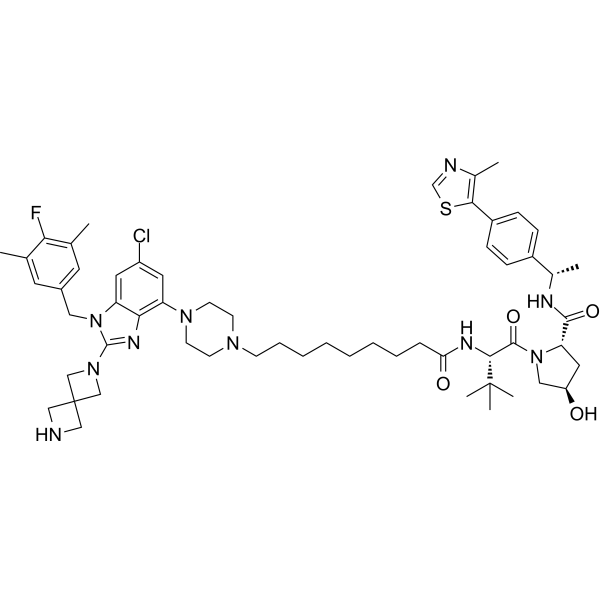Physicochemical Properties
| Molecular Formula | C57H76CLFN10O4S |
| Exact Mass | 1050.544428 |
| CAS # | 2913185-35-8 |
| Related CAS # | (4S)-PROTAC SOS1 degrader-1;2913176-81-3 |
| Appearance | Typically exists as solid at room temperature |
| InChi Key | AZBRWXRYNYEDKG-HAGVEIHTSA-N |
| InChi Code | InChI=1S/C57H76ClFN10O4S/c1-36-24-40(25-37(2)49(36)59)29-69-46-27-43(58)26-45(50(46)64-55(69)67-33-57(34-67)31-60-32-57)66-22-20-65(21-23-66)19-13-11-9-8-10-12-14-48(71)63-52(56(5,6)7)54(73)68-30-44(70)28-47(68)53(72)62-38(3)41-15-17-42(18-16-41)51-39(4)61-35-74-51/h15-18,24-27,35,38,44,47,52,60,70H,8-14,19-23,28-34H2,1-7H3,(H,62,72)(H,63,71)/t38?,44-,47+,52-/m1/s1 |
| Chemical Name | (2S,4R)-1-[(2S)-2-[9-[4-[6-chloro-2-(2,6-diazaspiro[3.3]heptan-2-yl)-1-[(4-fluoro-3,5-dimethylphenyl)methyl]benzimidazol-4-yl]piperazin-1-yl]nonanoylamino]-3,3-dimethylbutanoyl]-4-hydroxy-N-[1-[4-(4-methyl-1,3-thiazol-5-yl)phenyl]ethyl]pyrrolidine-2-carboxamide |
| Synonyms | PROTAC SOS1 degrader-1 |
| HS Tariff Code | 2934.99.9001 |
| Storage |
Powder-20°C 3 years 4°C 2 years In solvent -80°C 6 months -20°C 1 month |
| Shipping Condition | Room temperature (This product is stable at ambient temperature for a few days during ordinary shipping and time spent in Customs) |
Biological Activity
| Targets | SOS1 (DC50 = 98.4 nM) |
| ln Vitro |
PROTAC SOS1 degrader-1 (compound 9d) (0.1, 1 µM) exhibits SOSI degradation activity, with a 92.5% and 56.2 μM SOS1 protein degradation at 0.1 and 1 μM, respectively[1]. PROTAC SOS1 degrader-1 (0-2000 nM; 24 h) shows dose- and time-dependent SOS1 degradation activity in NCI-H358 cells, with a DC50 of 98.4 nM[1]. PROTAC SOS1 degrader-1 (0-2500 nM; 24 h) decreased the level of SOS1 protein in NCI-H358 and AsPc-1 cells in a dose-dependent manner, but had no effect on SOS2 or KRAS up to 2.5 μM[1]. PROTAC SOS1 degrader-1 (0-2000 nM; 24 h) significantly raises the pERK level after 6–24 hours, decreases the expression of KRAS–GTP, and induces ERK phosphorylation with an IC50 value of 72.3 nM[1]. |
| ln Vivo |
PROTAC SOS1 degrader-1 (10 mg/kg; i.p.) exhibits low toxicity and a good PK profile[1]. PROTAC SOS1 degrader-1 (0, 10, 20 mg/kg; i.p.; once a day for 3 weeks) exhibits noteworthy antitumor activities in the xenograft mouse model[1]. |
| Animal Protocol |
Male BALB/c mice[1] 10 mg/kg (dissolved in solution containing dimethyl sulfoxide, PEG400, and 10% hydroxypropyl-β-cyclodextrin in water (5/5/90, v/v/v)) I.p. |
| References |
[1]. Discovery of the First-in-Class Agonist-Based SOS1 PROTACs Effective in Human Cancer Cells Harboring Various KRAS Mutations. J Med Chem. 2022 Mar 10;65(5):3923-3942. |
Solubility Data
| Solubility (In Vitro) | May dissolve in DMSO (in most cases), if not, try other solvents such as H2O, Ethanol, or DMF with a minute amount of products to avoid loss of samples |
| Solubility (In Vivo) |
Note: Listed below are some common formulations that may be used to formulate products with low water solubility (e.g. < 1 mg/mL), you may test these formulations using a minute amount of products to avoid loss of samples. Injection Formulations (e.g. IP/IV/IM/SC) Injection Formulation 1: DMSO : Tween 80: Saline = 10 : 5 : 85 (i.e. 100 μL DMSO stock solution → 50 μL Tween 80 → 850 μL Saline) *Preparation of saline: Dissolve 0.9 g of sodium chloride in 100 mL ddH ₂ O to obtain a clear solution. Injection Formulation 2: DMSO : PEG300 :Tween 80 : Saline = 10 : 40 : 5 : 45 (i.e. 100 μL DMSO → 400 μLPEG300 → 50 μL Tween 80 → 450 μL Saline) Injection Formulation 3: DMSO : Corn oil = 10 : 90 (i.e. 100 μL DMSO → 900 μL Corn oil) Example: Take the Injection Formulation 3 (DMSO : Corn oil = 10 : 90) as an example, if 1 mL of 2.5 mg/mL working solution is to be prepared, you can take 100 μL 25 mg/mL DMSO stock solution and add to 900 μL corn oil, mix well to obtain a clear or suspension solution (2.5 mg/mL, ready for use in animals). Injection Formulation 4: DMSO : 20% SBE-β-CD in saline = 10 : 90 [i.e. 100 μL DMSO → 900 μL (20% SBE-β-CD in saline)] *Preparation of 20% SBE-β-CD in Saline (4°C,1 week): Dissolve 2 g SBE-β-CD in 10 mL saline to obtain a clear solution. Injection Formulation 5: 2-Hydroxypropyl-β-cyclodextrin : Saline = 50 : 50 (i.e. 500 μL 2-Hydroxypropyl-β-cyclodextrin → 500 μL Saline) Injection Formulation 6: DMSO : PEG300 : castor oil : Saline = 5 : 10 : 20 : 65 (i.e. 50 μL DMSO → 100 μLPEG300 → 200 μL castor oil → 650 μL Saline) Injection Formulation 7: Ethanol : Cremophor : Saline = 10: 10 : 80 (i.e. 100 μL Ethanol → 100 μL Cremophor → 800 μL Saline) Injection Formulation 8: Dissolve in Cremophor/Ethanol (50 : 50), then diluted by Saline Injection Formulation 9: EtOH : Corn oil = 10 : 90 (i.e. 100 μL EtOH → 900 μL Corn oil) Injection Formulation 10: EtOH : PEG300:Tween 80 : Saline = 10 : 40 : 5 : 45 (i.e. 100 μL EtOH → 400 μLPEG300 → 50 μL Tween 80 → 450 μL Saline) Oral Formulations Oral Formulation 1: Suspend in 0.5% CMC Na (carboxymethylcellulose sodium) Oral Formulation 2: Suspend in 0.5% Carboxymethyl cellulose Example: Take the Oral Formulation 1 (Suspend in 0.5% CMC Na) as an example, if 100 mL of 2.5 mg/mL working solution is to be prepared, you can first prepare 0.5% CMC Na solution by measuring 0.5 g CMC Na and dissolve it in 100 mL ddH2O to obtain a clear solution; then add 250 mg of the product to 100 mL 0.5% CMC Na solution, to make the suspension solution (2.5 mg/mL, ready for use in animals). Oral Formulation 3: Dissolved in PEG400 Oral Formulation 4: Suspend in 0.2% Carboxymethyl cellulose Oral Formulation 5: Dissolve in 0.25% Tween 80 and 0.5% Carboxymethyl cellulose Oral Formulation 6: Mixing with food powders Note: Please be aware that the above formulations are for reference only. InvivoChem strongly recommends customers to read literature methods/protocols carefully before determining which formulation you should use for in vivo studies, as different compounds have different solubility properties and have to be formulated differently. (Please use freshly prepared in vivo formulations for optimal results.) |
